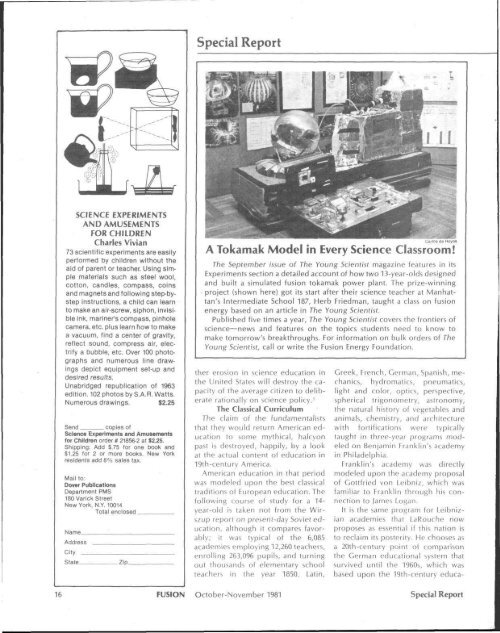Special ReportSCIENCE EXPERIMENTSAND AMUSEMENTSFOR CHILDRENCharles Vivian73 scientific experiments are easilyperformed by children without theaid of parent or teacher. Using simplematerials such as steel wool,cot<strong>to</strong>n, c<strong>and</strong>les, compass, coins<strong>and</strong> magnets <strong>and</strong> following step-bystepinstructions, a child can learn<strong>to</strong> make an air-screw, siphon, invisibleink, mariner's compass, pinholecamera, etc. plus learn how <strong>to</strong> makea vacuum, find a center of gravity,reflect sound, compress air, electrifya bubble, etc. Over 100 pho<strong>to</strong>graphs<strong>and</strong> numerous line drawingsdepict equipment set-up <strong>and</strong>desired results.Unabridged republication of 1963edition. 102 pho<strong>to</strong>s by S.A.R. Watts.Numerous drawings. $2.25A Tokamak Model in Every Science Classroom!The September issue of The Young Scientist magazine features in itsExperiments section a detailed account of how two 13-year-olds designed<strong>and</strong> built a simulated fusion <strong>to</strong>kamak power plant. The prize-winningproject (shown here) got its start after their science teacher at Manhattan'sIntermediate School 187, Herb Friedman, taught a class on fusionenergy based on an article in The Young Scientist.Published five times a year, The Young Scientist covers the frontiers ofscience—news <strong>and</strong> features on the <strong>to</strong>pics students need <strong>to</strong> know <strong>to</strong>make <strong>to</strong>morrow's breakthroughs. For information on bulk orders of TheYoung Scientist, call or write the <strong>Fusion</strong> Energy Foundation.ther erosion in science education inthe United States will destroy the capacityof the average citizen <strong>to</strong> deliberaterationally on science policy. 3The Classical CurriculumThe claim of the fundamentaliststhat they would return American education<strong>to</strong> some mythical, halcyonpast is destroyed, happily, by a lookat the actual content of education in19th-century America.American education in that periodwas modeled upon the best classicaltraditions of European education. Thefollowing course of study for a 14-year-old is taken not from the Wirszupreport on present-day Soviet education,although it compares favorably;it was typical of the 6,085academies employing 12,260 teachers,enrolling 263,096 pupils, <strong>and</strong> turningout thous<strong>and</strong>s of elementary schoolteachers in the year 1850. Latin,Creek, French, German, Spanish, mechanics,hydromatics, pneumatics,light <strong>and</strong> color, optics, perspective,spherical trigonometry, astronomy,the natural his<strong>to</strong>ry of vegetables <strong>and</strong>animals, chemistry, <strong>and</strong> architecturewith fortifications were typicallytaught in three-year programs modeledon Benjamin Franklin's academyin Philadelphia.Franklin's academy was directlymodeled upon the academy proposalof Gottfried von Leibniz, which wasfamiliar <strong>to</strong> Franklin through his connection<strong>to</strong> James Logan.It is the same program for Leibnizianacademies that LaRouche nowproposes as essential if this nation is<strong>to</strong> reclaim its posterity. He chooses asa 20th-century point of comparisonthe German educational system thatsurvived until the 1960s, which wasbased upon the 19th-century educa-16 FUSION Oc<strong>to</strong>ber-November 1981Special Report
<strong>Fusion</strong> Reporttional reforms instituted by the vonHumboldt brothers.As LaRouche writes: "Examiningthe postwar Federal Republic of Germanyat closer range, there is nodoubt but that it was chiefly the Germaneducational system, based on theHumboldt program, which enabledthe nation's people <strong>to</strong> rebuild successfullyafter the treble horrors ofHitler, World War II, <strong>and</strong> the Britishdirectedpostwar occupation."In an accompanying piece, "Principlesof the New Kameralist Curriculum,"LaRouche develops in detaila positive proposal for the reform ofthe nation's schools. In his introduc<strong>to</strong>ryremarks he states:"The key <strong>to</strong> all education, bothgeneral <strong>and</strong> later specialist programs,is a rigorous redefinition of what constitutesthe body of knowledge which'must be mastered by any person asprecondition for full rights of citizenship."The education of all citizens offuture true democratic republics isbased on the assimilation of a scienceof his<strong>to</strong>ry of the struggle <strong>to</strong> createsuch republics, against irrationalism<strong>and</strong> 'feudalist' oligarchism. The assimilationof a science of his<strong>to</strong>ry canno<strong>to</strong>ccur without a cohering masteringof the true potential powers of literatelanguage. This must be language inthe proper broadest sense of thatterm: classical philology, classical poetry,classical musical composition according<strong>to</strong> the well-tempered laws ofcomposition typified by Bach, Mozart,<strong>and</strong> Beethoven, <strong>and</strong> mastery of theprinciples of physical geometry."If we are <strong>to</strong> win the war againstliberal education, this program mustreceive the widest possible circulation.There is not much time <strong>to</strong> waste.—Carol WhiteNotes1. See Carol Cleary, "Darwin: A Victim of HisUnfit Theory," <strong>Fusion</strong>. Jan. 1981, p. 82.2. The 1852 English translation of Cosmos byE.C. Otte is recommended.3. Science <strong>and</strong> Engineering Education <strong>to</strong>r the1980s <strong>and</strong> Beyond, prepared by the NationalScience Foundation <strong>and</strong> the Department ofEducation, Oct. 1980.4. Unpublished research of Mary Gilbertson<strong>and</strong> Jon Pike.What's Behind the Science Magazine Attack?Reviewing <strong>Laser</strong> <strong>Fusion</strong> ProgressA deroga<strong>to</strong>ry review of the U.S.inertial confinement effort that appearedin the May 1 issue of Science,the weekly magazine of the AmericanAssociation for the Advancement ofScience, presents an opportunity <strong>to</strong>review the actual status of the inertialfusion effort <strong>and</strong> examine the ideologyof the antifusion faction. The article,authored by William D. Metz, istitled "Ambitious Energy Project LosesLuster," with the subheading "<strong>Laser</strong>fusion, <strong>to</strong>uted as a new energy source,has produced only fizzles; its militaryimplications now predominate."The Science article is curious no<strong>to</strong>nly because it deliberately lies, butalso because the magazine recentlyturned down a factual article on thestate of inertial fusion research by Dr.John Foster, a vice president at TRW,who had headed up the DOE's inertialfusion review committee during theCarter administration.Metz's apparent purpose in attackinglaser fusion is <strong>to</strong> bring about thecomplete classification of the program,ditching the civilian energy applications<strong>and</strong> making it solely a militaryeffort. Needless <strong>to</strong> say, such amove would retard fusion progress<strong>and</strong> prevent the kind of scientific exchangeof ideas that his<strong>to</strong>rically hasfostered breakthroughs at the frontiersof science. Metz has set up histechnical arguments against the program<strong>to</strong> put fusion scientists in a Catch22: To refute his arguments, it is necessary<strong>to</strong> report on material that iscurrently classified <strong>to</strong>p secret.As Metz does not report, every majorindustrial-scientific panel that hasreviewed the inertial fusion programover the past decade has concludedFigure 1This 1976 projection for the succession of laser fusion experiments at LawrenceLivermore was presented by Dr. John L. Emmett, direc<strong>to</strong>r of the Livermore<strong>Laser</strong> program, before Congress March 11, 1976. The results projected for theShiva laser have been achieved.<strong>Fusion</strong> ReportOc<strong>to</strong>ber-November 1981 FUSION 17
















